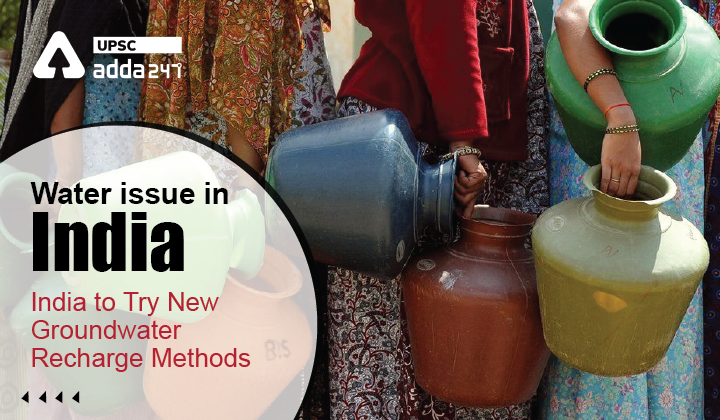Table of Contents
Water issue in India UPSC: Relevance
- GS 3: Conservation, environmental pollution and degradation, environmental impact assessment.
Water crisis in India: Context
- Recently, the central government has planned to recharge groundwater using treated water to alleviate water shortages in Tamil Nadu.
Water issue in India: Key points
- If the pilot proves to be successful, the method is likely to be replicated in other parts of the country as well.
- Lack of fresh water to recharge groundwater is a huge issue in Tamil Nadu where saline sea water has seeped into the soil, making it infertile.
- The artificial recharge project is being implemented in collaboration with the Netherlands.
Issue of water crisis in India
- NITI Aayog reported 30% Himalayan springs already dried up due to receding glaciers.
- The hydro-electricity projects in Alaknanda and Bhagirathi have turned upper Ganga into ecological deserts.
- Uranium contamination in groundwater due to mining in Rajasthan and Gujarat.
- Proposed neutrino observatory in Tamil Nadu could lead to leaching of chemicals in groundwater.
- Increasing incidence of water theft across the country.
- NITI Aayog’s composite water management index reported
- 600 million people faces high to extreme water stress.
- persistent water crises will lead to 6% loss in the country’s GDP by 2030.
- 75% of households do not have access to drinking water on premises.
- 70% households lack piped water.
Measures taken to manage the groundwater resources
- Jal Shakti Abhiyan (JSA): Launched in 2019 to improve water availability including ground water conditions in the water stressed blocks of 256 districts in India.
- Jal Shakti Abhiyan: Catch the Rain” (JSA:CTR): It has been launched with the theme “Catch the Rain – Where it Falls When it Falls” to cover all the blocks of all districts (rural as well as urban areas) across the country.
- Atal Bhujal Yojana: It is a Rs.6,000 crore Central Sector Scheme, for sustainable management of ground water resources with community participation.
- Master Plan for Artificial Recharge to Groundwater – 2020: It is a macro level plan prepared by the Central Ground Water Board. The plan envisages construction of about 1.42 crore rain water harvesting and artificial recharge structures in the country.
- National Aquifer Mapping and Management program (NAQUIM): It envisages mapping of aquifers, their characterization and development of Aquifer Management Plans to facilitate sustainable management of groundwater resources in the country.
- Other schemes: Artificial groundwater recharge/water harvesting works is also being supported MGNREGA and Prime Minister Krishi Sinchayee Yojana – Watershed Development component (PMKSY-WDC), ‘Surface Minor Irrigation (SMI) and Repair, Renovation and Restoration (RRR) of Water Bodies schemes’ a component of PMKSY.
Read current affairs for UPSC





 TSPSC Group 1 Question Paper 2024, Downl...
TSPSC Group 1 Question Paper 2024, Downl...
 TSPSC Group 1 Answer key 2024 Out, Downl...
TSPSC Group 1 Answer key 2024 Out, Downl...
 UPSC Prelims 2024 Question Paper, Downlo...
UPSC Prelims 2024 Question Paper, Downlo...





